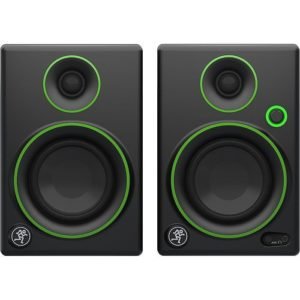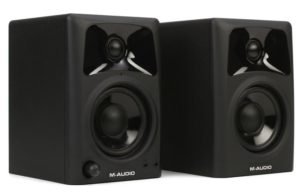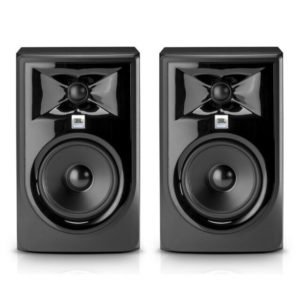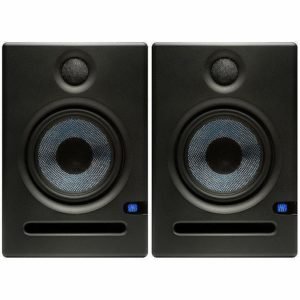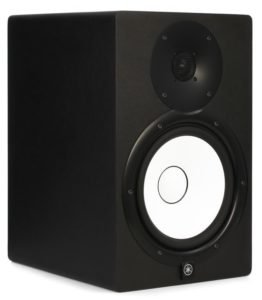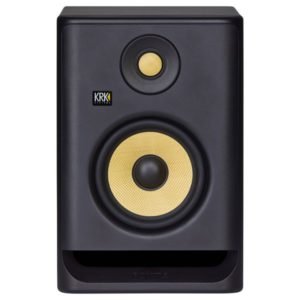Whether you’re just getting started with producing music or you want to upgrade your speakers with a limited budget, monitors are an essential part of your studio setup. It’s essential that you’re able to hear the ‘true’ or ‘honest’ sound of your tracks. However, with so many options and specifications that can be difficult to understand on the surface, you can easily end up spending a small fortune on studio monitors.
Not every producer has a large budget to work with. By scouring critic reviews and user feedback, this article outlines the best entry level studio monitors that are suited to a tight budget – ideal for home studios.
Best entry level studio monitors – Overview
The following monitors are budget friendly and offer the best return on sound quality:
Best entry level studio monitors – Detailed
1. Mackie CR3
These speakers are extremely affordable and ideal for producers starting out in home recording. The Mackie CR3s are well built bookshelf monitors that are clear and crisp in mid and high frequency ranges. At 3” in size, if you’re making music in a relatively small room or do not require high volume, the CR3s are an excellent entry-level option.
Usually what you sacrifice on when purchasing less expensive monitors is the depth and range of the low frequencies, but the bass is surprisingly full when considered in the context of the price and small size of the CR3s. If you require more clarity or punch in your bass, you can always purchase a subwoofer to achieve this further down the line.
One slight downside of these monitors is the lack of tuning options – if you want to alter the sound according to your studio environment, you’ll need to do so with an audio interface. However, if you’re just starting out with producing, you may not be too concerned about tuning at this point.
2. M-Audio AV32
The M-Audio AV32s are computer speakers that provide great sound quality, making them suitable for entry level music producers. As one of the most affordable budget speakers available, the AV32s offer solid performance with a clean sound and slight emphasis on the higher frequencies.
More specifically, the AV32s start off at around 20kHz and drop down to 80Hz on the frequency spectrum, meaning they have decent range for their size and price point. They have RCA inputs so you can connect mixers or your DJ gear, if you’re a DJ getting started in producing.
At 3” in size, these monitors are not able to output at a high volume. Therefore they are not ideal if your studio is a larger room, but suitable if you’re producing in a bedroom or small to medium sized room.
3. JBL LSR305
JBL makes great music hardware with high quality components and the LSR305s are a great example of this. They’re exceptionally built, producing a very clean, detailed sound, yet remain highly affordable and suitable for a home studio.
With a frequency range of 43Hz to 24kHz the JBL LSR305s offer great range and a depth in the lower frequencies that you won’t get with cheaper or smaller monitors. Using an advanced technology called Image Control Waveguard, they give you a very detailed sound with little distortion.
Across critic and user reviews, a common critique of the LSR305s is that if you position them against or very close to a wall, this will muddy the bass. If you opt for these monitors, ensure you have a space suitable to position them a few inches from a wall to avoid this.
4. PreSonus Eris E5
PreSonus began as a company known for their high quality mixers, but today they are high regarded for a variety of studio equipment, including studio monitors. The smallest of their monitor products, the PreSonus Eris E5 offers a solid frequency range (53Hz to 22kHz), a very well balanced sound and an impressive ability to output accurately at a high volume.
The Eris series includes extensive acoustic tuning controls, allowing you to tweak the frequency response of your speakers to account for the acoustic characteristics of the room you’re producing in.
The E5s are deceivingly powerful, making them ideal for producing and live DJ sets. However, like nearly any monitor under 6” in size, if your studio is in a reasonably large room or you’re determined to forensically test your tracks in the low-end of the frequency range, you probably require a larger monitor. The PreSonus Eris E8 is a very good option in this case.
5. Yamaha HS5
Like KRK Rokits, Yamaha HSs are a very highly regarded range of studio monitors. And like the Rokit’s, they cost more than other speakers on this list. The Yamaha HS5s are the smallest monitors of the range and hence the most affordable (similar cost to the Rokit G4s).
These monitors are renowned for their accuracy and detail, with a wide frequency range of 54Hz to 30kHz. In particular, compared to some of the cheaper speakers on this list, the bass is deep and powerful, while the mids are extremely clean, meaning you’ll hear any imperfections in your mix. This is key for producing any bass-driven music, including hip hop and EDM.
If your budget allows it and you’re producing music in a larger sized room, the bigger Yamaha HS8s offer awesome sound quality and an enhanced low-end response relative to the HS5s (and every other monitor on this list), perfect for mixing bass-heavy tracks.
6. KRK Rokit RP5 G4
These monitors can be found in studios everywhere and for many are instantly recognisable. They’re priced higher than other speakers on this list, but the KRK Rokit RP5 G4’s offer excellent sound quality across the audio frequency spectrum.
At the 5” size, you can expect to pay about £150 / $170 per speaker, but if your budget allows for this price range, you’ll be getting a pair of monitors that are accurate, reliable and accessible – they have an accompanying app that helps you achieve an optimal setup.
If you’re looking for a larger monitor, the 7”, 8” and 10” versions of the KRK Rokit G4’s offer increasing dynamic range and audio quality. You’ll find them both in beginner studios and in seasoned sound engineers’ studios.
What are the key considerations when buying studio monitors?
Depending on your requirements, these are the key areas of consideration before purchasing your studio speakers.
Budget – Of course, not everyone has a big budget to shop for studio monitors, but despite all the opinions and information you’ll come across, you can still buy good quality speakers without breaking the bank. Whilst it’s true that generally speaking, the more you spend the better quality speaker you’ll get, there are budget monitors out there that will help you achieve great sounding music.
Quality and frequency range – A high quality monitor will cover a wide frequency range without distortion (known as dynamic range). Humans can generally hear between 20Hz and 20KHz, so ideally your setup should have a dynamic range near this minimum and maximum threshold. Realistically, you need to invest a fair amount of money to purchase larger monitors that have a comprehensive dynamic range. However, for a beginner home studio, a dynamic range down to about 50Hz is definitely acceptable and fit for purpose.
Size – If you’re producing music at home, it’s likely that a small speaker will do the job for you. The smaller the speaker, the less volume and sound quality. However, unless you have a professional studio in a large space, smaller monitors are absolutely sufficient. 5” or perhaps even 3” speakers can output high quality and powerful sound in most home studios. If you do opt for 3” monitors in particular, you can always add a subwoofer to address deficiencies in the low-end frequency.
What’s the difference between studio monitors and speakers?
Regular speakers tend to enhance certain frequencies and are not built to replicate a sound exactly as it was produced. For instance, regular speakers often boost the bass. On the other hand, studio monitors are built to provide an accurate representation of an original recording. This is called a flat frequency response. As a music producer this is really important, as you want your speakers to playback the true sound of your production, so you can make changes to enhance its quality and ensure it sounds good on any speaker. If you’re using regular speakers as part of your home studio setup, it’s time to upgrade to studio monitors to take control of your mixes.
*As an Amazon Associate I earn from qualifying purchases.
An experienced DJ and beatmaker with a passion for all things sampling, Soulection and tech.

